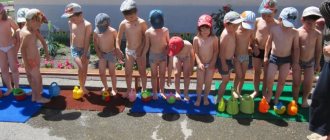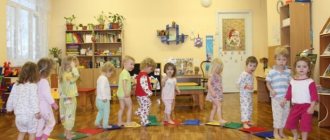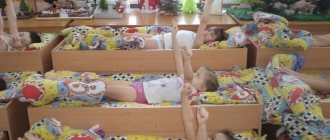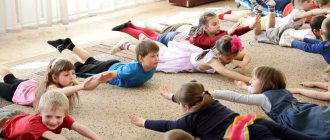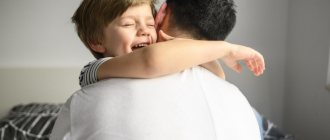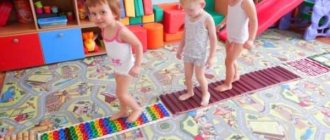COMPLEX OF INVOLVING GYMNASTICS AT MAY Educational and methodological material (senior group)
INVOLVING GYMNASTICS COMPLEX FOR MAY
1st complex "Zhuk"
IP: sitting, legs crossed. Shaking a finger. A beetle flew into our group, buzzed and sang: “Zh-zh-zh!”
Move your hand to the right, follow the direction of your hand with your eyes, and do the same in the other direction.
So he flew to the right, everyone looked to the right.
So he flew to the left, everyone looked to the left.
Move the index finger of your right hand towards your nose. The beetle wants to sit on your nose, we won’t let it sit.
The downward direction of the hand is accompanied by the eyes. Our beetle has landed.
Standing, legs apart. Make rotational movements with your arms (“spinning top”) and stand up.
It buzzed and spun, “Zh-zh-zh-zh-zh-zh-zh-zh-zh-zh.”
Move your hand to the right side, follow with your eyes. The same in the other direction.
Beetle, here is your right palm, sit on it for a while,
Beetle, here is your left palm, sit on it for a little while.
Raise your hands up, look up. The beetle flew up and sat down on the ceiling.
Rise on your toes, look up. We stood up on our toes, but we didn’t get the bug.
Clap. Let's clap together, Clap-clap-clap.
Simulate the flight of a beetle. So that he couldn’t fly away, “W-w-w-w-w-w-w-w-w-w-w-w.”
Beetle, here is your right palm, sit on it for a while,
Beetle, here is your left palm, sit on it for a little while.
Raise your hands up, look up. The beetle flew up and sat down on the ceiling.
Rise on our toes, look up We stood up on our toes, but we didn’t get the bug.
Clap. Let's clap together, clap-clap-clap.
Simulate the flight of a beetle. So that he couldn’t fly away, “W-w-w-w-w-w-w-w-w-w-w-w.”
2nd complex
1. “The eyes are waking up.”
We rub our eyes lightly, and then yawn sweetly.
I. p. - lying on your back, arms along the body. 1-4 - lightly stroke closed eyes; 5-8 - make a relaxing yawning sound. Repeat 4 times.
2. “The head woke up.” We almost woke up and smiled at each other.
I. p. - lying on your back, arms along the body. 1-2 - turn the head on the pillow to the right; 3-4 - and. P.; 5-6 - turn the head on the pillow to the left; 7-8 - and. n. When turning your head, smile at each other. Repeat 6 times
3. “Hands woke up.” We stretched out a little. Hello, sunshine in the window!
I. p. - lying on your back, arms along the body. 1 - raise your right hand up; 2-3 - pull your right hand; 4 - lower your right hand to the bed. The same for the left hand. Repeat 6 times.
4. “Legs woke up.” We also want to stretch and really, really wake up.
I. p. - the same. 1—raise your right leg straight up; 2-3 - stretch your right leg; 4 - lower your right leg onto the bed. The same for the left leg. Repeat 6 times.
5. “My legs are completely awake.” We'll shake our legs and count to three.
I. p. - lying on your stomach with support on your elbows, gently support your chin with your palms. 1-8 - alternately bend and straighten your knees. Repeat 4 times.
We go to wash, we go to dress -
Very friendly guys! Then we'll sing a song.
La la la la la la! This is who we are, friends!
Breathing exercises.
1. "Stork".
IP: As you inhale, raise your arms to the sides. Bring the leg bent at the knee proudly forward and fix it. As you exhale, take a step. Lower your leg and arms, saying “sh-sh-sh.”
2. Balloons."
I.p.: Perform while walking around the site. 1 - arms to the sides, up, inhale through the nose, clap your hands (“the ball burst”); 2 - arms to the sides, down, saying “ssss” or “sh-sh-sh” (“the ball has gone down”).
3. "Crow".
I.p.: o.s. Inhale through your nose, raise your arms up to your sides. Squatting, lower your hands to your head, saying “kar-kar-kar.”
4. “Here is a tall pine tree standing and moving its branches.”
I.p.: o.s. 1—inhale—arms to the sides; 2 - exhale - tilt the body to the right; 3 - inhale - return to the first position; 4 - the same to the left.
5. "Hedgehog".
I.p.: sitting, legs together, arms supported behind. Bend your knees and pull them towards your chest. Straighten your legs (“f-f-f”).
Five simple exercises for sound sleep
Literally 10 minutes of simple exercises before bed - and sound sleep is guaranteed.
Photo: Ruslan VORONOY, Express newspaper
Yuliana Shestak, a sports instructor, developed these exercises for her parents, who, like many older people, have problems with the spine. Juliana consulted with doctors and read specialized literature. As a result, a simple set of exercises was born that perfectly helps Juliana’s parents not only gently stretch the spine, but also makes it easier to fall asleep. And she was happy to share this complex with KP readers.
— The most important thing in these exercises is breathing. It should be deep, both inhale and exhale. You can start by slowly counting to yourself from one to five as you inhale, then slowly exhale. I myself, when I do this complex before going to bed, wake up the next morning cheerful and rested, without any pain. And I have a lot of workouts per day, which is why sometimes the lumbar spine begins to ache and ache.
This complex is not like others - there are repetitions only in breathing, and not in movements. All exercises are done on your back or sitting, so you can do them right in bed, before going to bed. In each exercise you need to take at least five deep breaths and exhalations. Over time, the number of breathing repetitions can be increased to ten.
1. “Turtle on its back”
Starting position - lying on your back, relaxed, without throwing your head back, but slightly pulling your chin towards your chest, so as to feel the tension in the cervical spine.
Gently pull your legs towards your chest, wrapping your arms around them. The legs should not be tense. Take a deep breath, hold your breath for a second, exhale completely. Try to breathe not with your chest, but with your stomach, feeling well how the muscles of the lumbar spine tense and relax as you inhale.
Repeat inhalation and exhalation five times.
.
Photo: Anna KUKARTSEVA
2. “Heron on his back”
From the previous position, gently extend one leg forward, placing your heel on the floor or bed. I left the second one pressed to my chest, holding it with my hands. Take five breaths.
Repeat with the second leg.
.
Photo: Anna KUKARTSEVA
3. Twisted twine.
Try to touch your knee to the floor on the opposite side. If that doesn’t work, place your foot on the knee of the other leg. You can simply place your foot behind your knee, as if crossing your legs.
In this twisted position, take five deep breaths. Remember to hold your breath for a couple of seconds between inhalations and exhalations. And remember - you need to breathe with your stomach, not your chest.
Switch legs. Take five more breaths.
.
Photo: Anna KUKARTSEVA
4. Twisted stretch.
Sit as wide as possible, stretch your legs, straighten your back. If you can't straighten your back, you can place a blanket or pillow under your buttocks to create support. Try to keep your back as straight as possible. Gently turn to the left, placing one hand between your legs and the other behind your left leg, as if leaning on them. Take five breaths. Gently turn to the right, repeating the procedure with breathing.
.
Photo: Anna KUKARTSEVA
5. “Legs are moving away...”
Sit down, bend your legs, press your stomach to them and clasp your thighs with your hands. Try to keep your back straight. Slowly begin to straighten your legs, slightly obstructing them with your hands.
.
Photo: Anna KUKARTSEVA
Straighten as far as the stretch allows - no need to strain, the exercise should be comfortable. You can leave your knees slightly bent. Try to cup your feet with your palms. If it doesn’t work, then start with the girth of the shins. Freeze, take five breaths and exhales.
.
Photo: Anna KUKARTSEVA
Such exercises do not injure the spine; they smoothly and gently train the muscles, saturating the blood with oxygen. Good sleep is guaranteed.
Verified by a KP correspondent :)
Gymnastics after sleep as one of the components of health-saving technologies
I am not afraid to repeat once again: Taking care of health is the most important work of a teacher. Sukhomlinsky Vasily Alexandrovich
Health is a great gift, without which it is difficult to make life happy, interesting and long. A healthy child is easier to raise, teach and educate. He develops the necessary skills and abilities faster. He adapts better to changing conditions and adequately perceives the demands placed on him. Health is the most important prerequisite for the formation of character, the development of will, and natural abilities. Currently, one of the priority tasks facing teachers is to preserve the health of children in the process of education and training. The methodological development I have presented is aimed at solving this problem. It presents ways to organize and conduct gymnastics after sleep. A consultation for parents has been developed. The formation of a healthy lifestyle should begin in kindergarten. There are no trifles in this matter. All life activities of a child in a preschool institution should be aimed at maintaining and strengthening health. Gymnastics after sleep is one of the most important building blocks in establishing the foundation of children’s health, which can only be strengthened if carried out systematically. It is difficult to overestimate the role of daytime sleep in the physical and intellectual development of a child. He simply needs a rest in the middle of the day. After a nap, children wake up lethargic and have low performance, as muscle tone is relaxed. All organs and systems (cardiovascular, respiratory, nervous, etc.) are not prepared for the stress that the child’s body will have to overcome during activities in the evening. But how can you help children wake up in a good mood and actively continue the day? Do gymnastics with your children after a quiet hour after bedtime. Gymnastics after daytime sleep is a set of activities that facilitate the transition from sleep to wakefulness. Invigorating gymnastics helps the child’s body wake up, improves mood, and improves muscle tone. After good gymnastics, children’s feelings of drowsiness, lethargy, and weakness disappear, mental and physical performance and activity increase, and the child’s mood and well-being improve. Gymnastics after a nap is a hardening procedure. The purpose of such gymnastics is to promote the quick and comfortable awakening of children after sleep. The objectives of gymnastics after sleep:
- increase the tone of the nervous system;
- strengthen muscle tone;
- contribute to the prevention of musculoskeletal disorders;
- help prevent colds;
- development of physical skills;
- maintain positive emotions when performing physical exercises and other routine moments in the afternoon.
Solving these problems allows you to smoothly and at the same time quickly increase the mental and physical performance of the child’s body. Gymnastics after sleep, its organization and implementation . The transition from the sleep state to the waking state occurs gradually. To facilitate the transition from a state of rest after waking up to a state of active wakefulness, you can turn on music. Music has a positive effect on children's emotions, creates a good mood in them, instills cheerfulness and joy, helps the rhythm of movements, and makes them easier to perform. Children learn to listen to music and coordinate movements with its character, to perform movements expressively and smoothly. It’s good if, after waking up, children hear their favorite children’s songs or calm, pleasant music, then they will wake up much faster. Don't forget to smile. The first thing a child should see after sleep is the smiling face of an adult, and also hear smooth, measured speech, pleasant intonations, and diminutive suffixes. Children subtly feel the emotions of others. An adult needs to be attentive to himself, monitor his facial expressions and emotional state. Children absorb the excitement, anxiety, irritability, and uncertainty of an adult immediately, like a sponge. All experiences will immediately affect the children’s mood. Invigorating gymnastics should be carried out in a well-ventilated area for seven to fifteen minutes, depending on the age of the children. A prerequisite for gymnastics is taking into account the individual characteristics of each child. Gymnastics consists of several parts:
- warm-up exercises in bed;
- performing simple self-massage (finger exercises) or acupressure;
- performing general developmental exercises at the crib (breathing exercises);
- walking on massage mats;
- Gymnastics can end with wiping with cold water or dousing (arms or legs).
In addition to general health-improving goals, each of the structural parts of invigorating gymnastics also solves its own narrower, specific tasks: Part I - gymnastics in cribs - gymnastics in bed is aimed at the gradual transition of children from sleep to wakefulness. It is better to spend it with the children who have woken up; the rest join in as they wake up. Gymnastics in bed can include elements such as stretching, alternately and simultaneously raising and lowering the arms and legs, elements of finger gymnastics, eye gymnastics, etc. The main rule is to exclude sudden movements that can cause muscle strain, overexcitation, and blood pressure drop. pressure and, as a result, dizziness. The duration of gymnastics in bed is about 2-3 minutes. Part II - corrective exercises, hardening procedures - is aimed at preventing flat feet and scoliosis, training children in basic movements (walking on toes, heels, on the outer and inner sides of the foot, with high knees, etc.), providing a hardening effect on the body. This part of the gymnastics is carried out in a well-ventilated group room using massage mats made by the children's parents. Part III – the final one – increases the child’s physical and emotional tone, creates a positive emotional mood in the group, and encourages further active activity. It can be carried out on the basis of game-type gymnastics using 3-6 simulation exercises. Gymnastics of a playful nature have a plot, they contain characters familiar to children, who are role models for the movements of birds, animals, plants, and children create various images (“skier”, “skater”, “gymnast”, “parsley”, “flower” and etc.). By adopting a certain play image, children often better understand the technique of performing a particular exercise. Children of middle and senior preschool age are very fond of invigorating gymnastics complexes in the form of musical and rhythmic exercises. Dance movements mobilize physical strength, develop grace and coordination of movements, strengthen muscles, and improve breathing. You can also use complexes with elements of acupressure, self-massage, and finger exercises. The essence of acupressure is reduced to mechanical irritation of biologically active points on the body that increase immunity. Carrying out gymnastics after a nap in a playful way allows you to create a positive emotional background and arouse increased interest in all health procedures. Thus, several problems are solved simultaneously: improving the health of children, developing their motor imagination, and developing meaningful motor skills. And most importantly, all this gives children great pleasure. All exercises are carried out at a free pace, without coercion. Each child performs exercises to the extent that is accessible and enjoyable to him. If a child for some reason does not want to perform an exercise, he can simply observe the execution, or perform it partially. The duration of the gymnastics is 7-12 minutes. This is determined by the age of the children and their state of health. It is advisable to use different versions of invigorating gymnastics throughout the year. Thus, daily performance of a complex of gymnastics, developed taking into account the patterns of functioning of the body after sleep and the individual characteristics of the child’s body, allows you to prepare the body for upcoming mental, physical and emotional stress, is a good means of preserving and strengthening health, preventing flat feet, provides high mental and physical performance during the second half of the day. Gymnastics after a nap increases the child’s overall level of physical activity, reducing the adverse effects of a sedentary lifestyle. A well-designed gymnastics complex does not cause negative emotions, at the same time it improves the mood, well-being and activity of the child, the tone of the central nervous system and increases the overall resistance of the body. The system of invigorating gymnastics built in this way helps the child’s body gradually and gently transition from sleep to active wakefulness with a simultaneous health-improving effect. Consultation for parents. INVOLVING GYMNASTICS AFTER SLEEP We all know the expression “got off on the wrong foot.” The mood that these words characterize is also familiar. Kindergarten teachers strive to ensure that children wake up after a nap in a good mood, cheerful and energetic. And parents should strive for this at home. Awakening is one of the most important moments contributing to the normal course of vital processes for the child. For this purpose, after daytime sleep, invigorating gymnastics is carried out; it is aimed at a gradual transition from sleep to wakefulness. It includes the following elements:
- stretching,
- alternately raising and lowering arms, legs,
- elements of self-massage,
- elements of finger gymnastics,
- gymnastics for the eyes,
- elements of breathing exercises.
The main rule is to avoid sudden movements that can cause muscle strain, overexcitation and, as a result, dizziness. Then invite the child to walk barefoot in panties:
- on toes,
- heels,
- on the outer and inner sides of the foot,
- with high knees,
- on massage mats.
In this case, you need to monitor the child’s posture and the correct execution of the exercises. Next, you can move on to performing a complex of breathing exercises, which is very important for:
- strengthening the immune system,
- prevention of colds,
- prevention of upper respiratory tract diseases.
At the end of the gymnastics, carry out water procedures (washing with cool water). It’s good if, after waking up, the child hears his favorite children’s songs, then he will probably wake up faster. In order to evoke an emotional response in children, you can use game exercises accompanied by various poems. For example:
